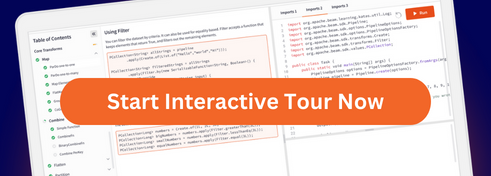Using RunInference from Java SDK
The pipeline in this example is written in Java and reads the input data from Google Cloud Storage. With the help of a PythonExternalTransform, a composite Python transform is called to do the preprocessing, postprocessing, and inference. Lastly, the data is written back to Google Cloud Storage in the Java pipeline.
You can find the code used in this example in the Beam repository.
NLP model and dataset
A bert-base-uncased natural language processing (NLP) model is used to make inference. This model is open source and available on HuggingFace. This BERT-model is
used to predict the last word of a sentence based on the context of the sentence.
We also use an IMDB movie reviews dataset, which is an open-source dataset that is available on Kaggle.
The following is a sample of the data after preprocessing:
| Text | Last Word |
|---|---|
| One of the other reviewers has mentioned that after watching just 1 Oz episode you’ll be [MASK] | hooked |
| A wonderful little [MASK] | production |
| So im not a big fan of Boll’s work but then again not many [MASK] | are |
| This a fantastic movie of three prisoners who become [MASK] | famous |
| Some films just simply should not be [MASK] | remade |
| The Karen Carpenter Story shows a little more about singer Karen Carpenter’s complex [MASK] | life |
Multi-language Inference pipeline
When using multi-language pipelines, you have access to a much larger pool of transforms. For more information, see Multi-language pipelines in the Apache Beam Programming Guide.
Custom Python transform
In addition to running inference, we also need to perform preprocessing and postprocessing on the data. Postprocessing the data makes it possible to interpret the output. In order to do these three tasks, one single composite custom PTransform is written, with a unit DoFn or PTransform for each of the tasks, as shown in the following snippet:
def expand(self, pcoll):
return (
pcoll
| 'Preprocess' >> beam.ParDo(self.Preprocess(self._tokenizer))
| 'Inference' >> RunInference(KeyedModelHandler(self._model_handler))
| 'Postprocess' >> beam.ParDo(self.Postprocess(
self._tokenizer))
)
First, the preprocessing of the data. In this case, the raw textual data is cleaned and tokenized for the BERT-model. All these steps are run in the Preprocess DoFn. The Preprocess DoFn takes a single element as input and returns a list with both the original text and the tokenized text.
The preprocessed data is then used to make inference. This is done in the RunInference PTransform, which is already available in the Apache Beam SDK. The RunInference PTransform requires one parameter, a model handler. In this example the KeyedModelHandler is used, because the Preprocess DoFn also outputs the original sentence. You can change how preprocessing is done based on your requirements. This model handler is defined in the following initialization function of the composite PTransform:
def __init__(self, model, model_path):
self._model = model
logging.info(f"Downloading {self._model} model from GCS.")
self._model_config = BertConfig.from_pretrained(self._model)
self._tokenizer = BertTokenizer.from_pretrained(self._model)
self._model_handler = self.PytorchModelHandlerKeyedTensorWrapper(
state_dict_path=(model_path),
model_class=BertForMaskedLM,
model_params={'config': self._model_config},
device='cuda:0')
The PytorchModelHandlerKeyedTensorWrapper, a wrapper around the PytorchModelHandlerKeyedTensor model handler, is used. The PytorchModelHandlerKeyedTensor model handler makes inference on a PyTorch model. Because the tokenized strings generated from BertTokenizer might have different lengths and stack() requires tensors to be the same size, the PytorchModelHandlerKeyedTensorWrapper limits the batch size to 1. Restricting max_batch_size to 1 means the run_inference() call contains one example per batch. The following code shows the definition of the wrapper:
class PytorchModelHandlerKeyedTensorWrapper(PytorchModelHandlerKeyedTensor):
def batch_elements_kwargs(self):
return {'max_batch_size': 1}
An alternative aproach is to make all the tensors have the same length. This example shows how to do that.
The ModelConfig and ModelTokenizer are loaded in the initialization function. The ModelConfig is used to define the model architecture, and the ModelTokenizer is used to tokenize the input data. The following two parameters are used for these tasks:
model: The name of the model that is used for inference. In this example it isbert-base-uncased.model_path: The path to thestate_dictof the model that is used for inference. In this example it is a path to a Google Cloud Storage bucket, where thestate_dictis stored.
Both of these parameters are specified in the Java PipelineOptions.
Finally, we postprocess the model predictions in the Postprocess DoFn. The Postprocess DoFn returns the original text, the last word of the sentence, and the predicted word.
Compile Python code into package
The custom Python code needs to be written in a local package and be compiled as a tarball. This package can then be used by the Java pipeline. The following example shows how to compile the Python package into a tarball:
pip install --upgrade build && python -m build --sdist
In order to run this, a setup.py is required. The path to the tarball will be used as an argument in the pipeline options of the Java pipeline.
Run the Java pipeline
The Java pipeline is defined in the MultiLangRunInference class. In this pipeline, the data is read from Google Cloud Storage, the cross-language Python transform is applied, and the output is written back to Google Cloud Storage.
The PythonExternalTransform is used to inject the cross-language Python transform into the Java pipeline. PythonExternalTransform takes a string parameter which is the fully qualified name of the Python transform.
The withKwarg method is used to specify the parameters that are needed for the Python transform. In this example the model and model_path parameters are specified. These parameters are used in the initialization function of the composite Python PTransform, as shown in the first section. Finally the withExtraPackages method is used to specify the additional Python dependencies that are needed for the Python transform. In this example the local_packages list is used, which contains Python requirements and the path to the compiled tarball.
To run the pipeline, use the following command:
mvn compile exec:java -Dexec.mainClass=org.apache.beam.examples.MultiLangRunInference \
-Dexec.args="--runner=DataflowRunner \
--project=$GCP_PROJECT\
--region=$GCP_REGION \
--gcpTempLocation=gs://$GCP_BUCKET/temp/ \
--inputFile=gs://$GCP_BUCKET/input/imdb_reviews.csv \
--outputFile=gs://$GCP_BUCKET/output/ouput.txt \
--modelPath=gs://$GCP_BUCKET/input/bert-model/bert-base-uncased.pth \
--modelName=$MODEL_NAME \
--localPackage=$LOCAL_PACKAGE" \
-Pdataflow-runner
The standard Google Cloud and Runner parameters are specified. The inputFile and outputFile parameters are used to specify the input and output files. The modelPath and modelName custom parameters are passed to the PythonExternalTransform. Finally the localPackage parameter is used to specify the path to the compiled Python package, which contains the custom Python transform.
Final remarks
Use this example as a base to create other custom multi-language inference pipelines. You can also use other SDKs. For example, Go also has a wrapper that can make cross-language transforms. For more information, see Using cross-language transforms in a Go pipeline in the Apache Beam Programming Guide.
The full code used in this example can be found on GitHub.
Last updated on 2025/12/28
Have you found everything you were looking for?
Was it all useful and clear? Is there anything that you would like to change? Let us know!



